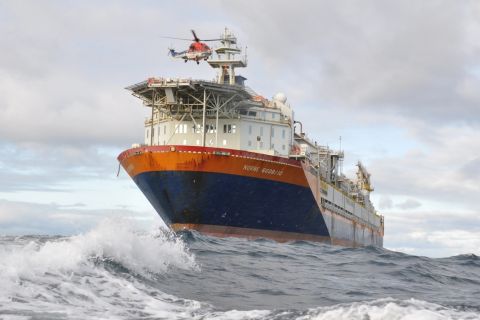
The energy sector is buzzing with talk of artificial intelligence, and Corva is capitalizing on its ability to synthesize complex data to optimize drilling operations with predictive drilling software. (Source: Shutterstock.com, Corva)
"Artificial intelligence" might just win the prize for the buzziest buzzword—especially in the energy sector.
Talk of AI is reaching a feverish high, and its ability to handle the massive amounts of data gathered from oilfield operations have players like Houston-based software developer Corva capitalizing on what some see as the next big thing to optimize the oil patch.
“If we’re collecting all of the data being generated by drilling operations: both streaming data; WITSML [well-site information transfer standard markup language] data; vibration data; RSS [rotary steerable systems]; and all your static data, such as fluids, reports, surveys, so on and so forth… Potentially, we have a good data set to be able to build some AI stuff on top of it,” William Fox, general manager for drilling at Corva, said during Hart Energy’s SUPER DUG Conference & Expo.
Fox said Corva has approximately 150 terabytes of clean drilling and completions data, growing by one terabyte to three terabytes a day depending on activity.
Central to Corva’s approach is the development of tools empowering operators to leverage AI capabilities effectively. The company’s predictive drilling tool simulates various drilling parameters in real-time to predict ROP, thereby optimizing drilling efficiency.
“Predictive drilling runs a model in the cloud of a bunch of different parameters—differential pressure being the most important—to simulate what the rate of penetration will be by varying differential pressure RPM, weight on bit and ROP,” Fox said.
Training the predictive drilling models requires the complete WITSML record, as well as BHA information, fluid information and other survey information for a minimum of 60 wells.
“When we started this in 2018, it took two years to build the first model that actually worked,” Fox told the audience. “Now it takes an afternoon to do a model run and do maybe three or four iterations, and then shadow test it and have the whole thing ready to go in between two and three weeks.”
However, there are always advances to be made, Fox said.
Corva has partnered with Nabors and its SMART ROS platform for what Fox calls “a real breakthrough.” The partnership enables safer and more effective drilling by extending rig controls and real-time data pipelines from the wellsite to the operator’s back office and mobile devices.
The full integration of this tool with Nabors’ SMART ROS drilling control and automation system marks a significant milestone, enabling seamless data exchange and real time decision-making on the rig.
“We developed an API interface to those rigs where we are pulling the live data from the field,” said Fox. “We are running that simulation and then about once every 10 to 15 seconds we have the capability to push set points back down to the rig to execute it.”
In typical drill operations, a driller might change set points around 3000 times in the intermediate and 2000 times in the lateral. With Corva and Nabors’ combined platform, said Fox, that number drops down to fewer than 100 times in the intermediate and fewer than 12 times in the lateral. These results begin to take place when AI control in rotary drilling reaches at least 70%, said Fox.
However, Fox said, technological innovation alone is insufficient without buy-in from drilling crews.
Success hinges on gaining the trust and cooperation of drillers and rig contractors to embrace AI-driven solutions. Through on-site presence, collaboration and the development of user-friendly interfaces, Corva aims to facilitate the adoption of its technology and maximize its impact on drilling operations.
Some operators are completely unwilling to share their data with other operators, while some are willing to share data anonymously. When building models, flexibility based on operators’ needs is important to be able to secure the data necessary to continue evolve.
“Where we’re going to be sort of mid-term is we’re going to do some automation around the model selection,” Fox said. “As you go to startup pad and build it in Corva, the system will actually test all of the models available against the offsets of the pad and tell you what model to use.”
Aside from automated model selection, Corva envisions further enhancements to its platform, including predictive alerts for critical events such as stuck pipe incidents and integration with additional drilling contractors.
And over the next six months, Fox said, Corva hopes to deploy RSS land and RSS offshore models to global customers.
The company is also exploring avenues to leverage advanced AI models, including collaborations with industry leaders like OpenAI, to unlock new possibilities in drilling optimization while safeguarding customer data.
“So in addition to predictive drilling and predictive alerts, we’ve also got the completions team working on comprehensive end-to-end metrics where you can take every input from drilling completions and production data and then try to run various cross plots to figure out what should be done differently to improve production over time.”
Recommended Reading
Technip Energies Wins Marsa LNG Contract
2024-04-22 - Technip Energies contract, which will will cover the EPC of a natural gas liquefaction train for TotalEnergies, is valued between $532 million and $1.1 billion.
Vår Selling Norne Assets to DNO
2024-05-08 - In exchange for Vår’s producing assets in the Norwegian Sea, DNO is paying $51 million and transferring to Vår its 22.6% interest in the Ringhorne East unit in the North Sea.
SLB OneSubsea JV to Kickstart North Sea Development
2024-05-07 - SLB OneSubsea, a joint venture including SLB and Subsea7, have been awarded a contract by OKEA that will develop the Bestla Project offshore Norway.
Exxon Mobil Green-lights $12.7B Whiptail Project Offshore Guyana
2024-04-12 - Exxon Mobil’s sixth development in the Stabroek Block will add 250,000 bbl/d capacity when it starts production in 2027.
Subsea7 Awarded Sizable Contract in GoM
2024-04-12 - Subsea7 will install a flowline for Talos’ Sunspear development in the Gulf of Mexico.






